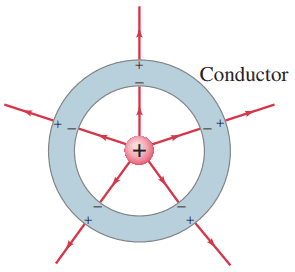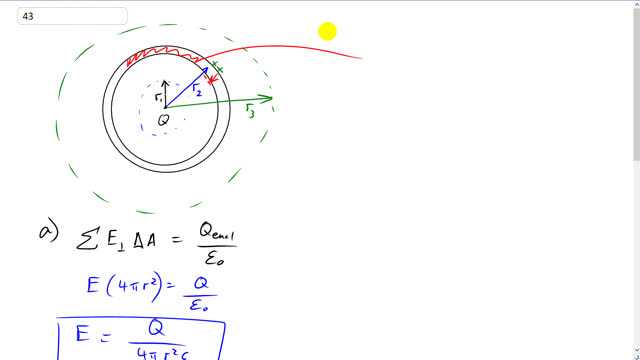
A point charge Q rests at the center of an uncharged thin spherical conducting shell. (See Fig. 16–34.) What is the electric field E as a function of
- for less than the inner radius of the shell,
- inside the shell, and
- beyond the shell?
- How does the shell affect the field due to Q alone? How does the charge Q affect the shell?

- Zero
- the shell has no effect on the field due to the charge, with the exception of within the thickness of the shell material where there is no field at all. The charge creates a charge distribution across the thickness of the shell.

In order to watch this solution you need to have a subscription.
This is Giancoli Answers with Mr. Dychko. We have a charge at the center here and it's surrounded by this conducting sphere with a certain thickness here and we have to find the electric field within the spherical shell. I should say it's a bit ambiguous to stay within because we're going to be calculating it really within the shell like within its thickness. Its radius r two is gonna be part b and then in part a we calculate the electric field enclosed inside in the interior of the shell here. And then in Part c we find the electric field and the exterior of the shell out here that radius r three. I can see that the electric field due to this positive charge which radiates outwards is going to create a charge distribution across the thickness of this shell because the shell is conducting that means its charges are free to move and so the negative charges will be attracted towards the inner surface of the shell as they try to get attracted to the positive charge enclosed within it and that'll leave behind some atoms with exposed protons on the other side and so this shell is being polarized. So first electric field in the interior of the shell and it's gonna be the total flux times the enclosed charge divided by permittivity of free space but the electric field is perpendicular to any spherical Gaussian surface and we can take electric field and multiply it by that surface area four Pi r squared. And that equals Q over Epsilon naught and divide both sides by four pi r squared and we get the electric field strength is Q divided by four Pi r squared times permittivity of free space Epsilon naught. Part b electric field is zero because inside a conductor since these charges can distribute themselves they will do so in such a way as to neutralize any electric field that's trying to go across the conductor and so electric field is going to be zero. If you want to think about it in terms of Gauss’s law you could say well consider it Gaussian surface in the interior of this conductor and it will contain this positive charge in the middle but it will also contain all these little negative charges that are accumulating on the inside surface of the conductor and things will work out such that all these little negative charges in the interior surface will have a total negative charge equal to the positive charge in the center so that there is a net charge of zero. So the net enclosed charge is zero. When you consider Gaussian surface within the thickness of this conducting shell. Part c says figure out the electric field on the exterior of this shell. The enclosed charge is still going to be Q, this charge in the middle of the sphere. Sure there's some positive charges on this outer surface and some negative charges on this inner surfaces but those will be equal so there's no net charge contributed by the conducting sphere. There's only this charge there in the end, in the middle. And so the formula be exactly the same as for the interior of the shell. And we still have electric field is Q over Epsilon naught times four Pi r squared same as part a. And in part d, the Shell has no effect on the field due to the point charge Q except for within the shell material. So we've shown in Part a and c that electric field has the same formula for Interior and the exterior of the shell but within the shell material itself there is no electric field and that's the only difference. And the charge does affect the shell because it creates this charge distribution across the thickness of the shell and it polarizes it, in other words, so the exterior of the shell will be positively charged in the interior surface of the shell would be negatively charged
Some more detail as to why the electric field is neutralized inside the shell would be helpful. It's not self evident to me that that's the case.